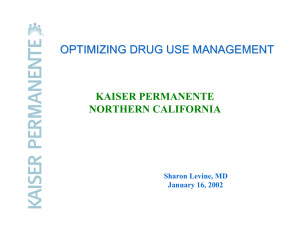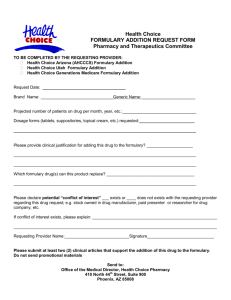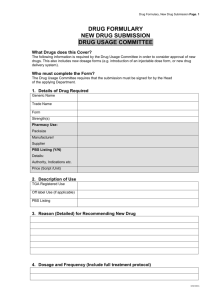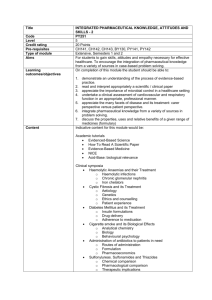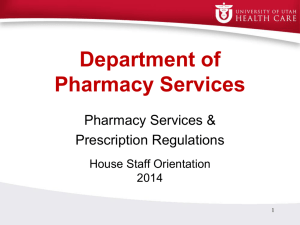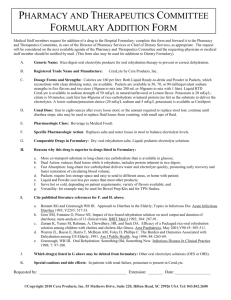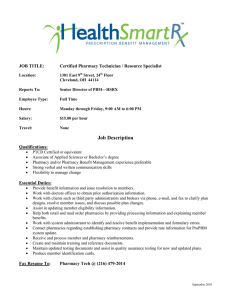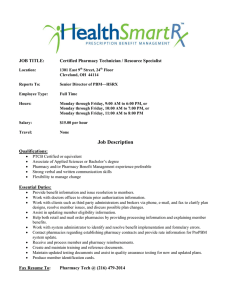2. Study Background Increasing Use and Cost of Pharmaceuticals
advertisement
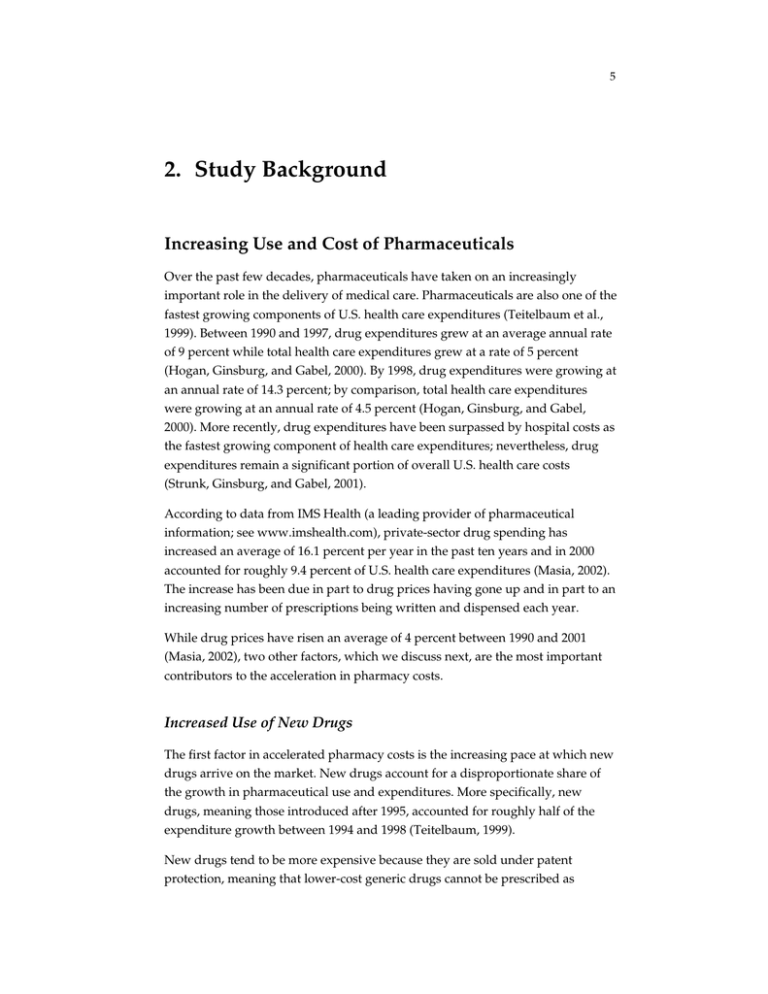
5 2. Study Background Increasing Use and Cost of Pharmaceuticals Over the past few decades, pharmaceuticals have taken on an increasingly important role in the delivery of medical care. Pharmaceuticals are also one of the fastest growing components of U.S. health care expenditures (Teitelbaum et al., 1999). Between 1990 and 1997, drug expenditures grew at an average annual rate of 9 percent while total health care expenditures grew at a rate of 5 percent (Hogan, Ginsburg, and Gabel, 2000). By 1998, drug expenditures were growing at an annual rate of 14.3 percent; by comparison, total health care expenditures were growing at an annual rate of 4.5 percent (Hogan, Ginsburg, and Gabel, 2000). More recently, drug expenditures have been surpassed by hospital costs as the fastest growing component of health care expenditures; nevertheless, drug expenditures remain a significant portion of overall U.S. health care costs (Strunk, Ginsburg, and Gabel, 2001). According to data from IMS Health (a leading provider of pharmaceutical information; see www.imshealth.com), private-sector drug spending has increased an average of 16.1 percent per year in the past ten years and in 2000 accounted for roughly 9.4 percent of U.S. health care expenditures (Masia, 2002). The increase has been due in part to drug prices having gone up and in part to an increasing number of prescriptions being written and dispensed each year. While drug prices have risen an average of 4 percent between 1990 and 2001 (Masia, 2002), two other factors, which we discuss next, are the most important contributors to the acceleration in pharmacy costs. Increased Use of New Drugs The first factor in accelerated pharmacy costs is the increasing pace at which new drugs arrive on the market. New drugs account for a disproportionate share of the growth in pharmaceutical use and expenditures. More specifically, new drugs, meaning those introduced after 1995, accounted for roughly half of the expenditure growth between 1994 and 1998 (Teitelbaum, 1999). New drugs tend to be more expensive because they are sold under patent protection, meaning that lower-cost generic drugs cannot be prescribed as 6 substitutes. However, in some cases, new drugs can be cost saving because they can offset their higher unit cost by reducing the need for more intensive and costly treatments, such as inpatient surgery. Newer pharmaceuticals may also increase overall pharmacy expenditures when they are developed for previously untreatable conditions or for conditions for which older drug therapies are not well tolerated. For example, over the past decade, this issue has been especially relevant in the use of newer drugs to manage HIV/AIDS, hepatitis C, and transplant rejection. Likewise, new drugs are prescribed to treat conditions, such as wrinkled skin, obesity, or habitual smoking, previously considered to be the side effects of aging or the results of lifestyle choices. Increased Prescription Drug Benefits and Direct-to-Consumer Marketing The second factor contributing to the growth of pharmaceutical costs is the increasing availability of prescription drug benefits packages in health insurance policies. Over the past two decades, the proportion of drug expenditures covered by insurers has grown (U.S. Department of Health and Human Services, 2000). This growth has tended to shift drug purchase costs from consumers to insurers and likely has decreased incentives for cost-effective prescribing (Teitelbaum et al., 1999; Newhouse, 1994). At the same time, evidence suggests that direct-to-consumer (DTC) marketing has shifted demand to some more-expensive drugs (Bozzette et al., 2001; Mintzes et al., 2002), as is believed to be the case with the allergy medication Claritin (generic name Loratadine). Consumers may not feel the impact of that shift and thus may have no incentive to request cheaper drugs if co-payments do not reflect relative differences in prices paid by their health plans. In addition, studies have demonstrated that DTC marketing, which has greatly increased since the Food and Drug Administration (FDA) issued guidelines on the subject in 1997, has greatly impacted patients’ requests for pharmaceuticals and in turn has driven prescribing decisions (Mintzes et al., 2002). It is important to note, however, that while spending for DTC marketing has increased, it represents only about 15 percent of the money spent on drug promotion and is highly concentrated on subgroups of products (Rosenthal et al., 7 2002). Drug detailing1 and other physician-oriented promotions continue to constitute the majority of marketing efforts within the pharmaceutical industry and can have a powerful impact on prescribing decisions. Management of Pharmaceutical Benefits Service delivery organizations that purchase drugs on behalf of beneficiaries have reacted to increasing pharmacy costs by managing the purchase and dispensing of drugs more aggressively. These activities typically take place in the context of “formulary management” or, as it is becoming more commonly known, “pharmacy benefits management.” Regardless of the term, the process of managing pharmaceutical care usually includes developing a list of covered drugs or preferred drugs (that is, a formulary or a preferred list, respectively) and implementing the processes required to monitor and control access to those drugs. In many cases, guidelines on dispensing activities (i.e., filling prescriptions) as well as rules for physicians in prescribing drugs are included in those processes. A survey of health maintenance organizations (HMOs) noted that more than 90 percent of HMOs now use some type of formulary process to manage pharmaceutical prescribing and dispensing (Hoescht, 1999). Nearly half of all HMOs use closed formularies (a limited set of selected pharmaceutical products) with other non-formulary drugs made available by waiver or by exemption. Other organizations use a more-open formulary system in which the availability of drugs is based on their status as generic, preferred, or non-preferred. In these instances, the pharmacy benefits package is often managed by a co-payment system with different, or tiered, price structures for various agents. Although the terms “closed formulary” and “open formulary” are traditionally used to describe how drugs are covered, the terms are becoming less meaningful because many of the techniques for managing pharmaceuticals are similar under both circumstances (Schulman, 1996; Flagstad, 1996). When access to some drugs is limited, responsibility for coverage decisions and oversight activities (such as ensuring appropriate prescribing and implementing pre-authorizations rules) is ultimately that of the health plan or the insurer. However, determination of the actual drugs included in a formulary or preferred list is typically delegated to a representative group of clinicians—mostly _________________ 1“Drug detailing” refers to the practice of pharmaceutical company representatives (who generally represent one or two specific medications) marketing their companies’ products by visiting physicians’ offices and providing free drug samples and informational materials. 8 physicians and pharmacists—who are typically convened by the benefit plan and are known collectively as the P&T committee. Over the past decade, health plans and insurers have frequently turned over the task of managing pharmacy benefits or formulary development to pharmacy benefits managers (PBMs). PBM activities may include any or all of the following. Therapeutic Switching or Substitution Therapeutic switching or therapeutic substitution refers to switching from one drug to another, usually on the basis of reducing costs while maintaining quality of care and, in some instances, improving clinical or therapeutic effect. Switching is often done because of price negotiations (discussed later) that secure discounts or rebates on certain drugs for health plans/insurers. Typically, switching involves substituting a branded product with a generic version or switching one branded drug with another branded drug within the same drug class. In some cases, a therapeutic switch may be between drugs from different pharmaceutical classes or may be proposed for reasons apart from cost savings, such as safety (e.g., one drug is thought to be safer than another drug for a covered population) or convenience (one drug formulation is easier to use than another). Pharmacy programs (as part of a health plan) that utilize the switching/substitution strategy usually require permission from the patient and/or physician to switch a prescription to another drug, although specific requirements are usually determined by the P&T committee or PBM. Step-Therapy Step-therapy refers to programs that ensure that trials of certain drugs in a therapeutic class are prescribed before other less-cost-effective, or more-toxic, drugs are used. Step therapy also can help assure that drugs that have greater scientific evidence of efficacy are used before drugs that have less of a demonstrated benefit. Disease Management Disease management includes programs that focus on optimizing pharmacologic therapy (e.g., adjusting the dosage or duration of prescribed medications or improving patient adherence to dosage instructions) and non-pharmacologic therapy (e.g., providing education on beneficial lifestyle changes and selfmonitoring of diseases or physical conditions). Many disease management 9 programs concentrate on patients with chronic conditions such as diabetes mellitus or coronary disease. Price Negotiation In cases in which the beneficiary population is large, pharmacy managers negotiate lower drug prices with manufacturers. This process, in turn, allows pharmacy managers to offer lower prices for particular agents within a therapeutic class. The intent is to steer prescribers to lower-cost drugs by excluding higher-cost alternatives from the formulary or by charging a lower copayment for the preferred drug relative to the costlier alternative. Other strategies to increase the use of preferred drugs include therapeutic switching programs and sharing of cost risks between providers and health plans. Third-party PBMs typically pass cost savings on to clients and retain a portion of the rebate to cover administrative costs and to generate a profit. Advantages and Disadvantages of Formulary Systems On the one hand, formularies and preferred lists present an opportunity to incorporate systematic reviews of scientific evidence on clinical effectiveness and cost effectiveness into coverage decisions and management activities. The adoption and implementation of formularies or preferred lists have the potential to improve health outcomes by promoting evidence-based medicine and to reduce costs by emphasizing cost-effective drug management and volume purchasing. On the other hand, overly restrictive formularies may potentially reduce quality of care by limiting access to clinically indicated medicines, thus increasing morbidity and/or mortality and, perhaps, causing the utilization of other types of health care. Yet, the threshold separating appropriately managed pharmaceutical benefits and overly restrictive drug availability remains unclear. Table 2.1 summarizes the potential advantages and disadvantages of formulary systems. Before determining the extent to which a formulary should control pharmaceutical care, sufficient data are needed to inform formulary decisions and policies. Bozzette et al. (2001) found that because of a lack of critical data, few health care organizations based their coverage decisions on rigorous and systematic assessments of the comparative effectiveness and costs of various drugs, despite a strong desire to do so. Interviews that other researchers have 10 Table 2.1 Potential Advantages and Disadvantages of Formularies and Formulary Management Practices Advantages Provide forum for provider education Increase patient safety by reducing adverse events and interactions Improve quality and control costs through a systematic review of clinical and economic literature, which helps to inform coverage decisions Disadvantages Could increase administrative costs for the benefit plan or for the consumer and could inconvenience the beneficiary/patient or the pharmacies Reduce quality of health care and increase costs of care through restricted access Cause disruptions in care Control costs by channeling market share to obtain volume discounts SOURCE: Blumenthal and Herdman (2000). had with medical directors revealed a shared perception that adequate data were either lacking, not specific enough to their own organizations or covered populations, or biased because the evidence was generated by pharmaceutical manufacturers (Luce, 1995; Bozzette et al., 2001). Research on the Impact of Formulary Systems The long-term effects of formularies on patient care and health outcomes are largely unknown. However, a variety of studies suggests that formulary policies can benefit health plans without impinging on patient care. For example, one goal of formulary policy is to improve cost-effective prescribing either by lowering costs while maintaining quality or by improving quality while maintaining costs. One method for testing the effects of formularies is to follow patients who have undergone a therapeutic substitution, such as the substitution of a generic formulation in place of a branded product, or who have been prescribed one branded drug in place of another. Foulke and Siepler (1990) demonstrated that switching from the anti-ulcer drug ranitidine to the anti-ulcer drug cimetidine resulted in dramatic cost savings while maintaining clinical outcomes. Ganz and Saksa (1997) found that switching between two versions of the long-acting antihypertensive agent nifedipine reduced costs and had similar outcomes before and after the switch. Dearing et al. (1998) noted a similar effect with a therapeutic switch from nifedipine to felodipine. Patel et al. (1999) found no significant differences in the percentage of patients meeting cholesterol targets before and after a change from the agent pravastatin to the similar agent lovastatin. In 11 addition, they found no differences in quality-of-life measures, patient satisfaction, or medication tolerance. Apart from studies on therapeutic switching, other research has shown several potential benefits of formulary policies. Those benefits include improving access to expensive drugs and reducing inappropriate use. For example, McCombs and Nichol (1993) found that outpatient drug treatment protocols that limited use of an expensive agent improved access to that medication for high-risk patients while reducing post-treatment health care expenditures. Rahal et al. (1998) found that restrictions on antibiotic choice minimized antibacterial resistance patterns. Smalley et al. (1995) found that prior authorization for selected non-steroidal anti-inflammatory drugs reduced costs but not access to appropriate care. In addition, formulary-related activities may promote more rational drug use policies (Gold et al., 1989; Weiner, Lyles, and Steinwachs, 1991) and may increase patient safety, especially in older and more-vulnerable patients, by reducing the use of agents that have greater side effects (Futterman, Fillit, and Roglieri, 1997; Monane et al., 1998). Despite the availability of findings from smaller-scaled focused studies, few large-scale studies on formulary-related activities have attempted to measure the impact of formularies on service use, costs, and health outcomes. The few that have done so suffer from methodological flaws. For example, in a longitudinal study of South Carolina Medicaid patients, Kozma, Reeder, and Lingle (1990) noted a negative association between expanded drug coverage and hospital admissions, resulting in a shift toward outpatient care. However, the national trend away from inpatient care and toward ambulatory care during Kozma and colleagues’ study period of the mid-1980s may have confounded the study outcome. Similarly, evidence derived from the Managed Care Outcomes Project suggested an association between restrictive formularies and increased health care costs (Horn et al., 1996; Horn, Sharkey, and Phillips-Harris, 1998). However, Horn and colleagues used data from only six HMOs and were unable to control for the effects of pre-existing differences in patient populations, organizational structures, and health care utilization. Other researchers’ attempts to adjust for confounding variables using statistical modeling were successful in explaining only a small part of the observed variance (Ross-Degnan and Soumerai, 1996; Kravitz and Romano, 1996). The potential adverse consequences of arbitrarily restricting access to medications were highlighted in an influential study by Soumerai et al. (1991). They found that a stringent three-drug limit per patient had negative effects on rates of nursing home admissions of older Medicaid patients. Soumerai et al. 12 compared the effects of a three-drug reimbursement policy, then in effect in New Hampshire, on Medicaid patients in that state with the outcomes for a matched cohort in New Jersey that did not have a similar policy. They found that the risk of admission to a nursing home increased about twofold, although no effect on hospital admissions was seen. After the three-drug limit was rescinded, the higher rates of nursing home admissions fell back to the initially observed rates, which suggested strongly that arbitrarily capping payments on drugs shifted health expenditures to more expensive venues. In contrast, Walser, Ross-Degnan, and Soumerai (1996) concluded that the loosening of very restrictive Medicaid formularies, as a consequence of the Omnibus Reconciliation Act of 1990, led to an increased number of drugs being made available to patients, but those drugs yielded only nominal potential therapeutic benefit. Motheral and Henderson (2000) demonstrated that a closed formulary reduced the use of brand medications within an employer plan and resulted in substantial savings to the payor; however, they noted that the time-frame limitation of the study likely resulted in a failure to detect any long-term changes in utilization and costs. While the results of this study are not generalizable to other closed formularies in other plans, the authors posit several reasons why the closed formulary reduced the use of brand medications including discretionary (i.e., unnecessary or marginal) pharmaceuticals. However, Motheral and Henderson also observed a lower rate of compliance among those in the closed formulary group who were initially taking non-formulary medications. Thus, the closed formulary may have promoted higher discontinuation rates for essential medications among formulary subjects, which could lead to adverse health effects and future cost consequences. Taken as a whole, the three large-scale studies we just cited suggest that arbitrary decisionmaking on drug coverage and/or overly restrictive reimbursement policies may have an adverse impact on patient care. However, the studies do little to help in rendering an overall assessment of formularies in general and even less to explore how a specific organization’s formulary or pharmacy benefits policy may impact patient care. This oversight is not entirely unexpected because, by their very nature, formularies are dynamic. Disentangling a formulary effect from the overall package of managed-care administrative activities that may affect physician decisions is difficult (Kreling and Mucha, 1992; Schulman et al., 1996). A number of methodological obstacles remain to be overcome when objectively evaluating the health outcomes of drug formularies and preferred lists (Rucker and Schiff, 1990). Nonetheless, three recent studies, one by Glassman et al. (2001), one by the U.S. General Accounting Office (GAO) (2001), and one by the Institute of Medicine 13 (Blumenthal and Herdman, 2000), which evaluated pharmaceutical management within the Department of Veterans Affairs (VA) may have some potential relevance to the DoD. Two of these studies queried VA physicians in order to measure the perceived impact of the VA National Formulary on a range of access and patient care issues. The first study (Glassman et al., 2001) found that the majority of responding physicians did not perceive that the National Formulary adversely impacted access to pharmaceuticals, quality of care, resident training, and clinical workload. Preliminary results from the second study (U.S. General Accounting Office, 2001) were generally consistent with those of the first study, suggesting that a majority of VA physicians agree that the VA formulary contains drugs needed for patient care and that they are able to obtain approvals for necessary non-formulary drugs. Although the two studies had a somewhat different focus, both assessed physicians’ attitudes about a national formulary and neither study found the relatively closed VA National Formulary to be overly restrictive. While the DoD is not proposing a closed formulary, nor is it proposing a closed system such as the VA’s, the data regarding physicians’ attitudes and experiences with formularies may provide some insight into how a new UF might be perceived among MHS prescribers. Given the lack of more-objective data about the global effect of formularies, Glassman et al. (2001) have pointed out that assessing prescriber perceptions of formulary policies, by means of survey research, may assist in better understanding the impact of formulary management activities on prescribing patterns. As yet, little is known about individual prescribers’ perceptions of and attitudes toward formularies and formulary management practices and the impact of those attitudes on clinical practice. As such, the baseline survey described in this report and required by Congress will provide some additional information in this regard. Until recently, survey data focused on only minor aspects of formulary care, such as providers’ perceptions regarding availability of specific drugs (Hasty, Schrager, and Wrenn, 1999), or addressed only general attitudes toward cost containment (Donelan et al., 1997; Schectman et al., 1995). The Department of Defense Pharmacy Programs The MHS serves roughly 8.7 million beneficiaries, who include active duty military personnel and their family members, retired military personnel and their family members, and surviving family members of deceased military personnel. The MHS is dedicated to pursuing two related goals: (1) ensuring military readiness through overseeing the health and well-being of active duty military personnel and (2) assuring that active duty dependents and retired military 14 families have access to health care services. The NDAA of FY 2001 expanded TRICARE benefits to also include Medicare-eligible military retirees. The military health benefit is organized and delivered through two systems in two distinct settings. In the direct-care system, the military provides direct care to active duty personnel and military beneficiaries in military-owned and operated treatment facilities (i.e., in MTFs). In the purchased-care system, the military health benefit pays for authorized care rendered by civilian providers outside MTFs. Both systems are administered through the TRICARE program. Part of the TRICARE program includes providing access to pharmaceuticals. The DoD processes approximately 65 million prescriptions annually. In recent years, DoD expenditures on pharmaceuticals have risen dramatically, mirroring trends in the civilian sector. For example, in 2001, the DoD spent just over $2 billion on pharmaceuticals, which represents a 28 percent increase from 2000. In April 2001, the DoD introduced a new pharmacy benefit for Medicare-eligible military retirees, greatly expanding the availability of drugs to this population and increasing the DoD’s exposure to such costs. Costs have risen steadily over the past several years, from a 7 percent increase in 1996 to a 28 percent increase in 2001 (a 17 percent average increase over the six-year period). MHS beneficiaries may obtain prescriptions at one of the following four points of service: (1) outpatient pharmacies at MTFs; (2) the NMOP, administered by a single private contractor; (3) retail network pharmacies established by TRICARE contractors; and (4) non-network retail pharmacies. Each program has its own purchasing and distribution system, patient cost-sharing requirements, and process for establishing formulary inclusion and access to non-formulary drugs. Currently, 587 MTF pharmacies serve the three military services and 15 TRICARE health service regions. MTF pharmacies process approximately 52 million prescriptions annually (representing roughly 80 percent of all prescriptions processed for MTF beneficiaries).2 In 2001, drug expenditures in MTF pharmacies totaled approximately $1.2 billion. In addition, 40,000 retail pharmacies serve four separate managed-care-support contract networks under TRICARE. These pharmacies process approximately 12 million prescriptions annually. In 2001, drug expenditures in retail pharmacies totaled approximately $500 million. The NMOP processes approximately 1.5 million prescriptions annually. NMOP drug expenditures were approximately $300 million in 2001. ________________ 2Information about DoD expenditures for pharmaceuticals was drawn from presentations given by Colonel William Davies to medical residents at Baylor University, May 9, 2001, and by Colonel Daniel Remund, director of the DoD Pharmacoeconomic Center, during a TRICARE conference in February 2002 in Washington, D.C. 15 Prior to 1999, no single entity within the DoD had responsibility for administering and coordinating pharmacy programs (U.S. General Accounting Office, 1999a). The DoD took an important step in this direction by chartering under TRICARE the PharmacoEconomic Center (PEC), whose stated mission is “to improve the clinical, economic, and humanistic outcomes of drug therapy in support of the readiness and managed care missions of the MHS.” The PEC is engaged in a range of activities that relate to this mission. These activities include conducting pharmacoeconomic studies, providing analytic support to the DoD and NMOP P&T committees, providing customer support to users of the PDTS, assisting in the development and management of pharmacy-related information systems, and publishing an educational newsletter targeted to prescribers and other stakeholders that covers cost-effective drug therapies. Other PEC activities include assisting the Defense Supply Center–Philadelphia (DSC-P), a defense agency that negotiates prices with individual pharmaceutical manufacturers, and VA Pharmacy Benefits Management in contract negotiations with pharmaceutical manufacturers and participating in the development of pharmaceutical-related components of clinical practice guidelines. 3 The following subsections briefly describe the DoD’s three prescription systems—the direct-care system, the purchased-care system, and the NMOP. The Direct-Care System Prescribing of pharmaceuticals in the MTF system is governed by a national, yet locally tailored, formulary system. First, a DoD P&T committee establishes a “core” formulary that is shared by all MTFs. The Basic Core Formulary (BCF)4 established in April 1998 contains the minimum set of drugs that each MTF pharmacy must have on its formulary to support the primary-care scope of practice for primary-care manager enrollment sites (TRICARE Prime provider sites). The BCF contains two closed therapeutic classes—HMG CoA (3-hydroxy-3 methylglutaryl co-enzyme A) reductase inhibitors (otherwise known as “statins”) and nonsedating antihistamines. Adhering to these closed classes, under the DoD’s National Pharmaceutical Contracts, provides system-wide cost avoidance. To supplement the core formulary, local MTF P&T committees can add drugs to create site-specific MTF formularies that are tailored to the particular mission of _________________ 3The PEC Web site describes this program more fully (www.pec.ha.osd.mil/PEC_Chrt.htm). 4Information on the Basic Core Formulary was found at www.pec.ha.osd.mil/ac01001.htm (last accessed July 2, 2002). 16 and scope of practice within that MTF. However, the DoD mandates generic substitution when available. MTFs obtain drugs through the DSC-P. In general, the DoD obtains highly competitive prices relative to those granted to health plans and pharmaceutical benefits manufacturers that are as much as 70 percent less than the average wholesale prices (U.S. General Accounting Office, 1999a).5 Despite relatively low unit prices for pharmaceuticals, defense budget cuts during the 1990s and an increasing demand for prescription drugs put pressure on MTF drug budgets. The need to control pharmacy costs, combined with DoD rules assuring that all beneficiary groups have equal access to drugs, has resulted in MTFs dropping formulary coverage of selected popular and expensive drugs and not adding newer drugs as they have gained FDA approval (U.S. General Accounting Office, 1999a). Drugs that are not on MTF formularies can be made available through a nonformulary waiver. Prescribers can obtain non-formulary drugs for their patients by either one of two methods. The first method is called a “special drug request” (sometimes also referred to as a “special patient purchase”). Procedures for obtaining drugs through this method vary and are left to the local DoD base commander’s discretion. A frequent practice is for the prescriber to complete a special drug request form and forward it through departmental clinical directors to the MTF pharmacy. The chief pharmacist is usually delegated the authority to make interim approval (thus immediate purchase) or interim denial decisions, pending the next P&T committee meeting. The P&T committee then recommends approval or denial; appeals of denials are made to the MTF’s Hospital Executive Committee and the commander. An alternative method requires the patient to fill the prescription though a retail pharmacy, which bypasses clinical directors, the P&T committee, Hospital Executive Committee, and commander. This practice, in addition to bypassing all institutional oversight, is very costly to the DoD because drugs dispensed in this way do not receive the substantial discounts available to the government under federal pricing. Prescriptions written by non-MTF prescribers (whether affiliated with TRICARE or not) for medications not covered by the MTF formulary cannot be filled at MTF pharmacies. In simple cases, the pharmacist can call the prescribing doctor and have the prescription changed to one that is on the MTF formulary. At present, all beneficiaries have the option to get their prescriptions filled through a ________________ 5Average wholesale prices often significantly overstate prevailing prices in the marketplace after rebates are taken into account. As such, 70 percent below average wholesale price may not be below the market average price for some drugs after rebates. 17 network retail pharmacy for a nominal co-payment. However, prior to FY 2001, Medicare-eligible military retirees not eligible for base realignment and closure (BRAC) benefits did not have this option. 6 Thus, rewriting prescriptions that needed to be filled in MTFs created additional demands for the already limited appointment times. Prescribers are discouraged from submitting special patient purchase requests on behalf of patients who are being treated outside the MTF. These requests place MTF doctors in a precarious position from a quality of care perspective.7 Little is currently known about any formal or ad hoc processes to deal with these requests and the additional workload they entail. The Purchased-Care System The fees that the DoD pays to TRICARE managed-care support contractors cover the cost of prescription drugs dispensed in retail network and non-network pharmacies. Providers who treat TRICARE beneficiaries outside MTFs basically have an open formulary with which they can prescribe all FDA-approved drugs, with the exception of drugs intended to treat conditions explicitly excluded from coverage under TRICARE benefits, such as those for smoking cessation and weight loss. Some TRICARE contractors have asserted that increased restrictions on MTF formularies are to blame for overruns in pharmaceutical budgets because prescriptions for items not available in MTFs are filled at retail pharmacies, where the cost savings to the DoD are not as large (U.S. General Accounting Office, 1999a). While the TRICARE formulary is currently unrestricted for network providers, the prescribing practices of almost all community providers, including those who treat TRICARE beneficiaries, are increasingly governed by formularies and pharmacy benefits policies. In many cases, community providers are confronted with a multitude of formularies and preferred lists because most of those providers care for patient populations covered by a variety of insurers. Because no standard formulary exists across health plans, prescribers are exposed to numerous policies and prescribing regulations. Anecdotal evidence suggests that community providers are increasingly frustrated with the limits that formularies place on their prescribing practices and perceive those limits to be arbitrary rather than based on sound clinical and cost-effectiveness criteria. _________________ 6Prior to FY 2001, Medicare-eligible retirees living in catchment areas for closed MTFs were eligible to use the NMOP as part of the BRAC agreements. 7Colonel William Davies, director, DoD Pharmacy Programs, personal communications, September 8, 2000. 18 Several recent studies support these perceptions and suggest that formulary inclusion decisions are driven in large part by volume discounts obtained when plans steer market share toward a particular drug in a therapeutic class (Schulman et al., 1996; Bozzette et al., 2001). These changes are likely to lead to frustration on the part of providers, as they perceive that formulary decisions are made for economic rather than clinical reasons. Moreover, these types of decisions necessarily involve prescribers as the agents of change (e.g., for a therapeutic switch), thereby increasing their workload. The fact that prescribers often must adhere to multiple conflicting formulary policies from multiple payers adds to the challenges they face. Therefore, it should not be surprising if prescribers regard dealing with various sets of formularies or drug lists and prescription procedures as an onerous task that is time-consuming and cumbersome. Thus, although TRICARE does not currently have a formulary or preferred drug list, prescribers’ experiences with other pharmacy benefits packages and health plans may not only influence the type of prescriptions they write for TRICARE patients but will also form the basis for how they initially perceive and interact with the UF once it is implemented. Prescribers may have negative perceptions of the UF for reasons totally unrelated to any problems inherent in the formulary itself. The National Mail Order Pharmacy In 1998, in response to cost concerns, the DoD carved away the mail-order dispensing of drugs from TRICARE contracts and replaced it with a single NMOP. The DoD P&T committee determines which drugs are available through the NMOP and the rules governing the dispensing of those drugs, such as the rules that define which drugs require prior authorization before being dispensed. The NMOP program is currently administered and managed through a contract with Merck-Medco Managed Care. Beneficiaries can obtain a 90-day supply of drugs (or a 30-day supply for controlled medications including narcotics) for a lower co-payment than the co-payment to fill prescriptions at retail pharmacies. In addition, refillable prescriptions initially filled through the NMOP can be obtained relatively quickly by ordering through the mail, by telephone, or over the Internet. The NMOP prescriptions are subject to safety review and undergo mandatory generic substitution. 8 ________________ 8The NMOP program is described in greater detail at http://www.tricare.osd.mil/pharmacy/ nmop.cfm. 19 Concerns About the Current System The DoD’s management of its three prescription programs has been the subject of scrutiny by the GAO (U.S. General Accounting Office, 1998 and 1999a) acting at the behest of Congress. The GAO evaluations noted a number of concerns in several areas. The first of these concerns arose from the lack of pharmacy data from TRICARE contractors and the overall lack of integration between medical records and pharmacy data. However, with the implementation of the Pharmacy Benefit Redesign Program in 2001 and more specifically the implementation of the PDTS in 2001 across all points of service, this concern has been largely addressed. The PDTS provides for a comprehensive and coordinated tracking system that enables providers to capture potential drug-drug interactions and monitor safety issues. A second concern arose from inconsistencies in the drug benefit. Until April 1, 2001, access rules and cost sharing for pharmaceuticals schedules differed across eight classes of beneficiaries: active duty (in TRICARE Prime), active duty family member in TRICARE Prime, active duty family member in TRICARE Extra or Standard, retirees and dependents under age 65 in TRICARE Prime, retirees and dependents under age 65 in TRICARE Extra or Standard, Medicare-eligible retirees, Medicare-eligible retirees with BRAC benefits, and Medicare-eligible retirees in TRICARE Senior Prime. The three pharmacy programs and eight beneficiary classes resulted in 24 different drug benefit schemes (see U.S. General Accounting Office, 1998, Table 3.1). Again, with the implementation of the new co-payment structure in April 2001, the eight classes of beneficiaries were eliminated and replaced with a streamlined co-pay structure based on the formulary status of the drug rather than the status of the beneficiary. A third concern was that co-payments were largely unrelated to what the DoD pays to acquire the medication; thus, co-pays provided little incentive for beneficiaries to seek out dispensing locations with the lowest costs to the DoD, with the exception of the incentives for using network versus non-network retail pharmacies. Moreover, for many beneficiary types, uniform co-payment schedules, ranging from five to nine dollars, did not discourage their purchasing prescriptions for more expensive alternatives within a drug class. Providers and patients had little incentive to switch to less-expensive agents within a drug class, as might occur within the statin or angiotensin converting enzyme inhibitor drug classes, when the co-payment structure for preferred and non-preferred drugs was similar. The new UF program and the three-tier co-pay structure, discussed in the next section, seek to address this issue. 20 The Structure of the Uniform Formulary Program As noted in Chapter 1, the NDAA for FY 2000 requires the DoD to integrate its pharmacy programs with the UF and directs the DoD to develop additional systems to administer drug benefits (e.g., the PDTS).9 The UF will be an open formulary that is intended to include the entire range of generic and brand-name drugs required to treat DoD beneficiaries. Although the details of the UF are still in the rule-making/comment stage as of this writing, in the following sections we include an overview of the proposed rule as published in the Federal Register (“Civilian Health and Medical Program …,” 2002). The proposed rule is subject to change during the comment period and will not be considered final until it is published in the Federal Register. Following the publication of the final rule, the DoD P&T committee will determine the contents of the UF, and a Beneficiary Advisory Panel will be given the opportunity to voice their comments to the director of the TRICARE program before the UF is implemented within the MHS. Access to and Availability of Pharmaceuticals In accordance with the proposed UF rule and the NDAA FY 2000 statute, the UF “shall assure the availability of pharmaceutical agents in the complete range of therapeutic classes authorized under the TRICARE prescription benefit.” According to the proposed UF rule, pharmaceutical agents in each therapeutic class will be selected for inclusion in the UF based on their relative clinical effectiveness and cost effectiveness. If an agent is determined to not have a significant, clinically meaningful therapeutic advantage compared with other drugs included on the UF, or if it is determined to be not cost effective relative to other UF drugs, it may be classified as a non-formulary agent. Agents used exclusively for medical conditions that are excluded from the TRICARE benefit by statute or by regulation will not be considered for inclusion in the UF. All pharmaceutical agents included on the UF shall be available through the MTF pharmacies, and the availability shall be consistent with the scope of practice at such facilities. The BCF that is currently in place will become a subset of the UF and will continue to be a mandatory component of all MTF pharmacy formularies. ________________ 9Information on the structure of the UF and coverage decisionmaking is from a DoD report to Congress on the subject in December 2000; personal communications with Colonel William Davies, director, DoD Pharmacy Benefits Program, September 8, 2000, and “Civilian Health and Medical Program . . .,” (2002), pp. 17948–17954. 21 The proposed rule also sets forth procedures to determine which agents will be included in the UF and which will require prior authorization before they are dispensed, and to determine generic drug classification, availability of nonformulary medications to members of the uniformed services and eligible covered beneficiaries, and reduction of co-payments for cases of clinical necessity. Cost Sharing and the Three-Tier Co-Payment Structure The FY 2000 NDAA legislation allows the DoD to designate a three-tier copayment price structure based on the classification of the prescribed drugs: (1) generic drugs (with the least-expensive co-payment); (2) formulary or preferred drugs (with the next-least-expensive co-payment); and (3) non-formulary or nonpreferred drugs (with the most-expensive co-payment). Active duty members currently do not pay a cost share and will continue not to do so. Cost sharing for all other beneficiaries will be based upon the pharmaceutical agent’s classification in the UF (i.e., generic, formulary, or nonformulary) and the point of service (i.e., MTF, retail network pharmacy, retail non-network pharmacy, or the NMOP) from which the agent is acquired. The copay structure, organized by point of service, is outlined in Table 2.2. The Uniform Formulary Versus the Current System The UF program will represent a major shift for the purchased-care system, in which formularies currently are open and offer few opportunities for the DoD to manage drug benefit costs. For the direct-care system (i.e., drugs dispensed at the MTF), the proposed UF will provide an expanded BCF and allow local MTF P&T committees to continue to make additions based on the scope of care. For the NMOP (for prescriptions written by either a direct-care provider or purchasedcare provider), the UF will make non-formulary medications available at the third-tier co-pay. In the retail network pharmacies (again, for prescriptions written by either a direct- or purchased-care provider), the UF makes the nonformulary medications accessible at the third tier co-pay for a 90-day supply. 22 Table 2.2 Proposed Three-Tier Co-Payment Structure Point of Service MTF No cost Network Retail $3 per prescription for 30-day supply NMOP $3 per prescription for a 90-day supply Tier 2: Formulary proprietary brands No cost $9 per prescription for a 30-day supply $9 per prescription for a 90-day supply Tier 3: Nonformulary, nonpreferred brands Not available unless prescribed by an MTF provider and approved through special order process $22 per prescription for a 30-day supply $22 per prescription for a 90-day supply Tier 1: Generic brands Non-Network Retail $9 or 20% (whichever is greater) per prescription for a 30-day supply $9 or 20% (the greater of the two) per prescription for a 30-day supply; deductibles and point of service penalties also apply $22 or 20% (the greater of the two) per prescription for a 30-day supply; deductibles and point of service penalties also apply Development and Maintenance of the Uniform Formulary The NDAA requires the DoD P&T committee to develop and maintain the UF. The committee will consist of government and non-government clinical staff. Its primary function will be to define the UF, excluding drugs only if they do not have a “significant, clinically meaningful” therapeutic advantage over other included drugs in terms of safety, effectiveness, or clinical outcomes. The UF development will occur in six stages: 1. Identification of the universe of covered therapeutic classes. 2. Identification of candidate drugs in each class. 3. Evaluation of drugs within each class to determine their relative safety and clinical efficacy. 4. Consideration of the relative costs of drugs in a particular class in relation to safety and clinical efficacy to determine their relative cost-effectiveness. 23 5. Identification of candidates for exclusion from the UF on the basis of Steps 3 and 4. 6. Submission of recommendations to the Uniform Formulary Beneficiary Advisory Panel for review and comment. Surveys to Assess the Impact of the Uniform Formulary on Prescribers To assess prescribers’ perspectives on the perceived impact of the UF within the Military Health System, the TMA asked RAND to conduct a confidential survey of TRICARE prescribers who practice in MTFs or within network facilities following implementation of the UF. RAND will administer the postimplementation survey of MHS prescribers to assess the impact of the UF on prescribers in terms of their workload, sense of autonomy, patient access, and patient relationships, and to assess their perceptions of the uniform formulary’s impact on the quality and cost effectiveness of care. To establish a baseline for a better understanding of prescribers’ current prescribing behavior and their knowledge of and attitudes about formularies and formulary management systems, RAND conducted a pre-UF (i.e., baseline) survey in 2001. The following chapters outline the methods and results of that baseline survey effort.
